Xerochrysum bracteatum
Strawflower, Xerochrysum bracteatum, is an annual in the Gnaphalieae group, which is in the huge Asteraceae, or Compositae family.
It is related to thousands of other plants, including the aster, daisy, and sunflower.
You may also find this flower classified under the names Helichrysum bracteatum and Bracteantha bracteate, and referred to as paper daisy, golden everlasting, everlasting flower, and everlasting daisy.
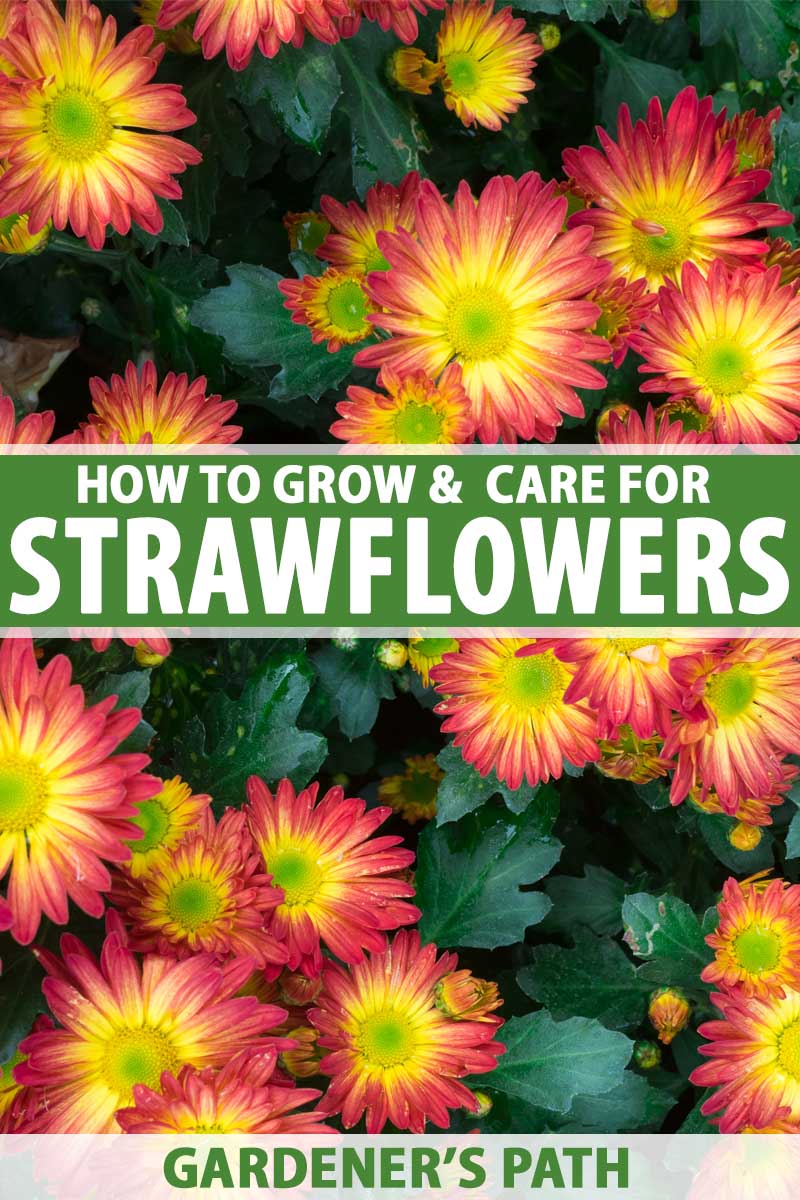
We link to vendors to help you find relevant products. If you buy from one of our links, we may earn a commission.
Read on to discover how easy it is to grow strawflower in your garden, enjoy cheerful blooms from summer to frost, and have a steady supply of long-lasting flowers for fresh and dry floral arrangements.
What You’ll Learn
Cultivation and History
On average, strawflowers are between two and three feet tall. There are smaller dwarf varieties of about 15 inches, and giants over three feet. The taller the plant, the sturdier the stems.
The blossoms have crisp, petal-like bracts that are usually referred to as petals. In fact, they are dry, dead tissue. The true flowers are the tiny florets that make up a dense, center disc, that may match or contrast with the bracts.
The entire flower head may be as small as one inch, or as large as three inches, with a single or double set of “petals.”
Strawflower is a continuous bloomer. Deadheading and flower harvesting throughout the growing season prevent seed formation and prolong flowering.
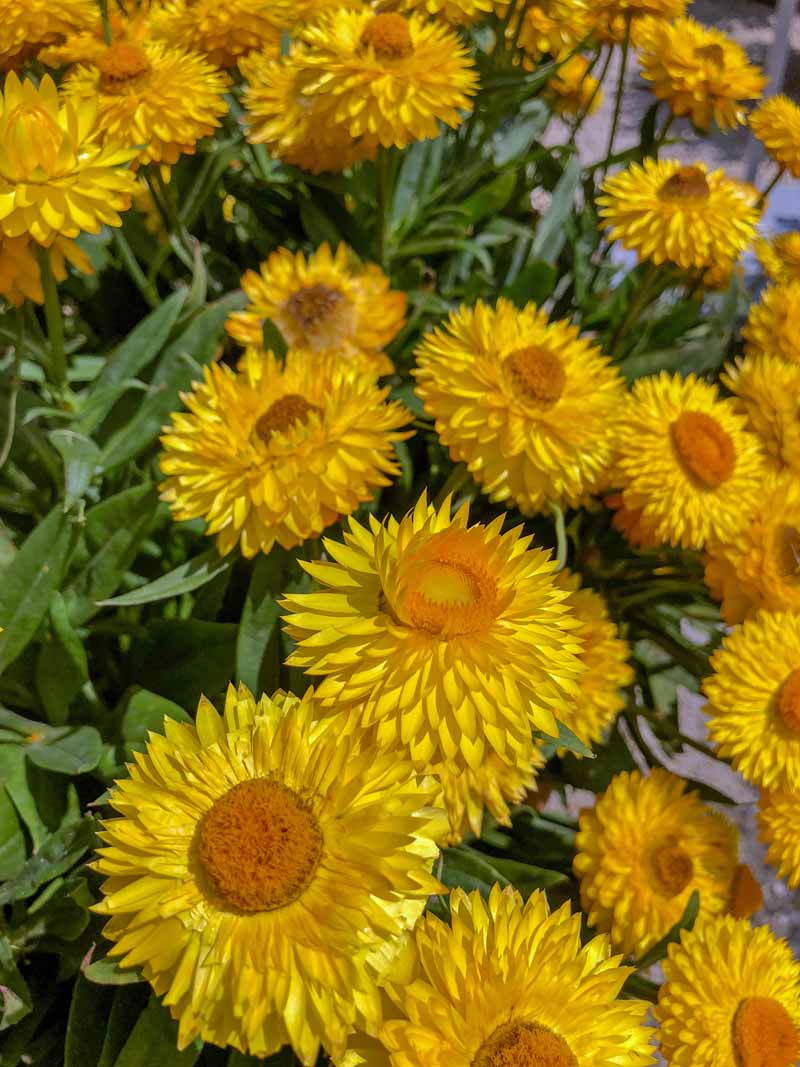
Native to the grasslands of Australia, the strawflower made its way to Europe in the 1800s, where the nobility prized it for having anti-inflammatory properties when brewed into tea.
Today’s cultivars come in shades of orange, pink, purple, white, and yellow, with either matching or contrasting centers. They are tender perennials in USDA Hardiness Zones 8 to 10, and annuals in cooler temperate zones.
Optimal Growing Conditions
X. bracteatum does best in a location with full sun, where the soil is slightly acidic, nutrient-rich, and well-draining. With good soil, fertilizer is not needed.
To determine your soil’s pH and nutrient content, contact your local agricultural extension office about testing your garden soil.
Working a couple of inches of organically rich compost into soil will boost essential nutrients. You may also apply doses of compost tea and/or bone meal periodically during the growing season.
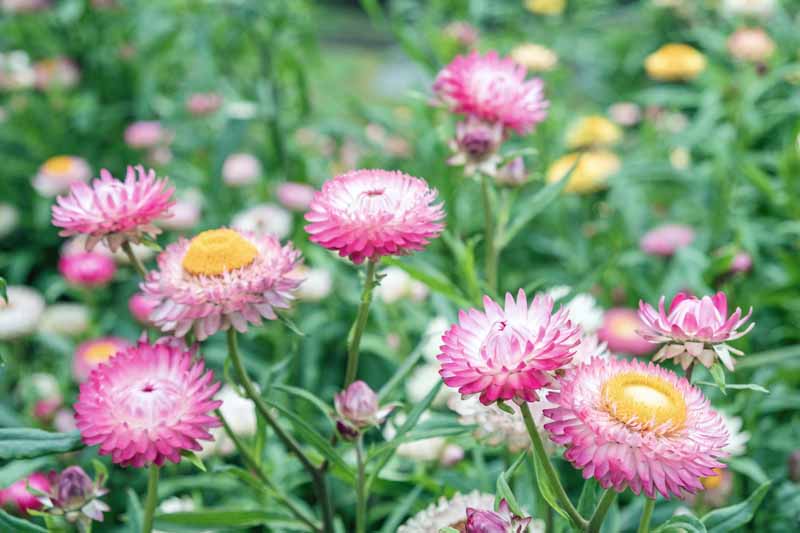
Another way to increase the nutrients available to plants is to use a well-balanced, slow-release fertilizer. A weak dose during the seedling stage followed by a full dose at first bloom, and another applied mid-season, will help plants thrive optimally.
If you choose to fertilize without conducting a soil test, be sure to choose a product with the lowest amounts of potassium, nitrogen, and phosphorous (PNK) you can find, or you may actually inhibit the plant’s ability to absorb the food it needs by adding too much of a good thing.
Strawflower Plant Propagation
To grow X. bracteatum in your garden, begin with seed or cuttings.
Hybrids, or crosses between two or more cultivars, do not reproduce true from seed, and are only available as cuttings. So, if you’re a seed saver, know that if you harvest seed from a hybrid, it may contain characteristics very different from the parent plant.
Start Seed Indoors
You may start seeds indoors up to two months before the last predicted frost date for your region. This how most folks start their:
- Fill the cells of an old egg carton with potting medium or use biodegradable seed starter soil blocks.
- Moisten the potting medium/soil.
- Place several seeds per cell/block.
- Place the cartons or blocks on a newspaper-lined tray in a sunny spot. Be sure to keep the soil moist, but not soggy. The paper will absorb watering overflow.
- Soon the seeds will germinate and grow cotyledons, or “seed leaves.” Next, they will get their first true set of leaves.
- Thin the seedlings out to one per cell/block.
- When the last frost date has passed, and you see at least two sets of leaves on all seedlings, it’s time to harden them off.
- This is a simple process of giving them a few hours a day outdoors, to acclimate to the weather in your yard. Do this for three or four days.
- Next, it’s time to transplant the seedlings to the garden or permanent pots.
- Choose a sunny garden location and work the soil down about 12 inches, adding compost if desired. Alternatively, fill a container with nutrient-rich potting medium.
- If you’re using egg carton cells, cut them apart with scissors.
- Settle each cell or seed starter block into the soil 10 to 12 inches of space around each. Tamp down gently.
- Set your garden hose nozzle to mist and moisten the soil around the seedlings to a depth of about three inches. Let the water soak in and repeat. Then tamp again.
Direct Sow Seed
It is possible to sow seeds directly into the planting bed:
- Prepare your garden soil as above, or fill containers with potting medium.
- Moisten the soil to a depth of about three inches, let the water soak in, and repeat.
- Once the water has soaked in, sprinkle seeds over the moist soil. Do not cover them.
- Proceed as above, thinning after true leaves appear, and allowing 10 to 12 inches between plants.
- Keep the soil moist, but not soggy, while plants mature.
Transplant a Nursery Pot
For a potted nursery plant, prepare your garden soil or fill your container with potting medium.
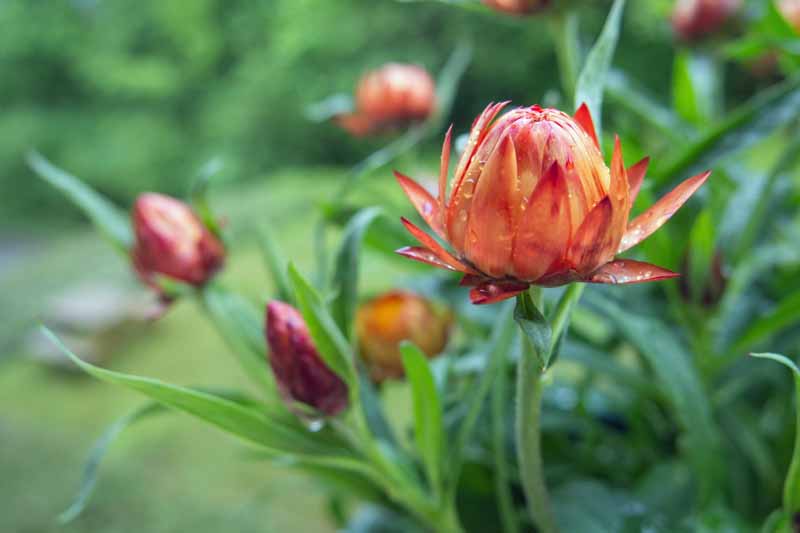
Unpot the plant and gently loosen any visible roots. Settle it into the soil at the same depth it was growing in the pot. Tamp the soil firmly around it. Water and tamp again.
Plant a Cutting
If you live where X. bracteatum grows as a perennial, and you have a hybrid plant that doesn’t produce true from seed, you may take a cutting in spring to root a new plant.
This is easy to do. With a clean pair of scissors or your favorite pruners, make a clean cut through a new shoot that has emerged from last season’s root crown. Dip it into rooting hormone powder and plant it in potting medium.
Keep the medium moist, but not water-logged.
When your new shoot has several sets of leaves, transplant it to the garden as we did above with germinated seedlings.
Tips for Success
When starting seeds indoors, be sure to water at the soil level, not over the seedlings themselves. The stems and leaves are very tender and may scorch in the sun.
During the germination, seedling, and transplant stages, do your best to keep the soil moist, but not over-saturated. Once a plant is established in the garden or a permanent pot, it has low water needs with excellent heat and drought tolerance.

Plants growing in the ground will tolerate hot, dry conditions better than those in pots, so be sure to water containers once they completely dry out.
Observe the recommended spacing to allow for optimal airflow, and prevent fungal growth.
Keep weeds to a minimum to prevent airflow obstruction, competition for water, and insect infestation.
For cutting flowers, choose taller varieties for the sturdiest stems.
Cut stems for arranging, or deadhead spent blossoms often, to encourage more flower formation.
Care and Maintenance
There is little to do once strawflower is established.
Watering needs are low when there is occasional rain in the forecast. However, don’t mistake heat and drought tolerant for “needs no watering.” If it doesn’t rain for a week or so, water lightly at the root level, but don’t overdo it. Drier is better than wetter.
If you are growing this flower as a tender perennial, prune away the old growth each spring to make way for new shoots. In addition, whether you grow as an annual or perennial, the frequent cutting of stems, either for arranging or the removal of spent flowers, is a great way to enjoy a long bloom season.
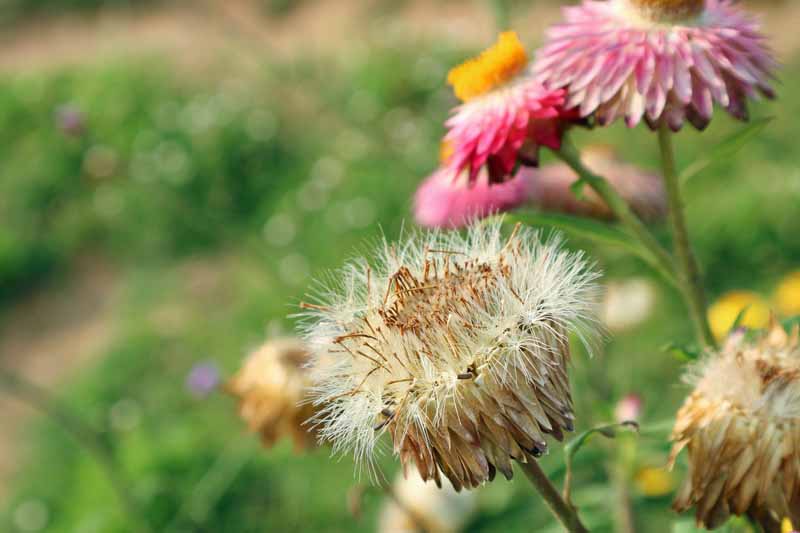
And finally, tall varieties can usually hold their own, but if they list to one side after a battering from stormy weather, use bamboo sticks and twine or some other form of staking to restore them to their upright positions.
Growing Tips
- Water during periods of heat and drought.
- Avoid overwatering and keep weeds to a minimum.
- Prune or deadhead to encourage new growth and extended blooming.
- Stake tall stems as needed.
Best-Loved Strawflower Cultivars
An artist’s palette of pinks and purples, oranges, yellows, and snowy whites in various sizes awaits the grower of X. bracteatum.
‘Bright Rose’ blossoms as a solid rosey red and then develops a brilliantly contrasting yellow center. These flowers retain their color when dried and make an excellent specimen for cutting gardens.
‘Bright Rose’ via Eden Brothers
A majestic height of up to three and a half feet earns it a prominent place in the landscape.
‘Golden Yellow’ is a taller variety with orange tipped bright yellow blossums.
‘Golden Yellow’ via Eden Brothers
Plant in cobalt blue containers flanking the front door for instant curb appeal.
Dave’s Garden’s peach/apricot mix, available on Amazon, is the perfect cutting flower for both fresh and dried presentations.

David’s Garden Seeds Apricot/Peach Mix
The plants reach up to 40 inches in height and produce 2 1/2 inch flowers in the most amazing hues of old fashioned peach.
The jewel-like ‘Magenta Red’ has a dense yellow center and reaches a height of up to 40 inches for an eye-catching back-of-border anchor.
‘Magenta Red’ seed via Eden Brothers
The ‘Swiss Giant’ has snowy white bracts surrounding a yellow ringed white center.
‘Swiss Giant’ via Eden Brothers
It also tops out at a towering 40 inches tall, and is reminiscent of the Alps in twilight.
And yes, you can get mixes for the perfect cottage garden look.
Strawflower, Tall Mixed Colors via Burpee
Burpee offers a tall mix while Eden Brothers offers a drawf mix.
Pest and Disease Control
X. bracteatum is not prone to pests or disease, especially when you start with quality seed or healthy nursery plants.
However, if you don’t provide for adequate air circulation, you may increase the humidity between plants and create a breeding ground for fungus, like powdery mildew.
Similarly, if you overwater, you may invite fungal growth, or rot the roots of your plants.
And the flip side, underwatering, may inhibit the uptake of essential nutrients and cause plants to fail to thrive. Chlorosis is a prime example. It’s the result of a failure to absorb iron that results in yellow leaves.
Various insects, such as leafhoppers or grasshoppers, may nibble occasionally. But you can deter them by keeping weeds down, and applying diatomaceous earth.
Role in the Garden Scheme
If you’re looking for a hardworking annual, strawflower fits the bill. Place shorter varieties in the front of beds and borders, in patio containers, window boxes, and hanging planters. Let taller types anchor beds and make dramatic linear statements in large containers.
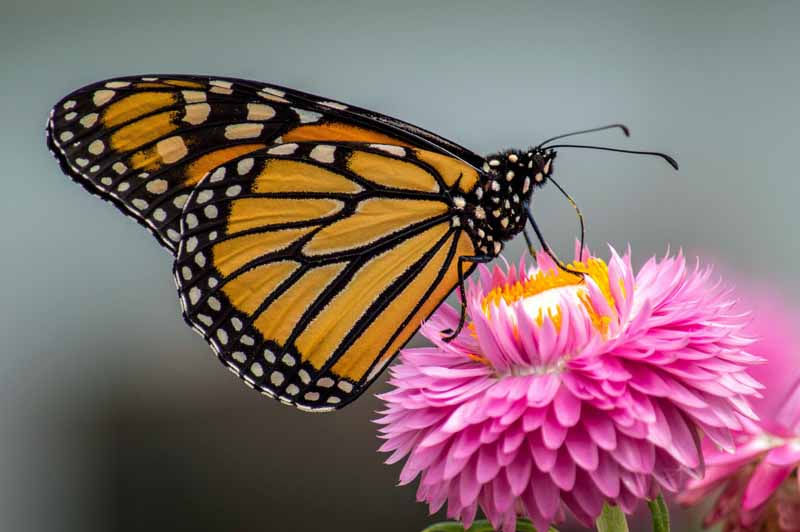
Use monochromatic or multi-colored schemes for drifts of color that sweep through your landscape with continuous blooms that just beg to be cut and arranged.
As a floral designer, I appreciate the versatility I have with strawflower. And as a gardener, I love that it attracts birds, bees, butterflies, and a host of beneficial pollinators, helping to make my yard a real habitat for wildlife.
Companion Plants
When planning a garden scheme, it’s helpful to know what plants “play well” together, or share a common growing culture. Some good companions for X. bracteatum are black-eyed Susan (Rudbeckia), balloon flower (Platycodon grandifloras), bee balm (Monarda didyma), yarrow (Achillea millefolium), and zinnia (Zinnia).
And, these flowers have something else in common. Because of their low water and care needs, they are suitable for xeriscaping, an environmentally sound type of gardening that requires minimal resources to maintain.
Best Uses: Cutting and Drying
To cut strawflower for fresh arrangements, choose sturdy stems with blossoms that have begun to open, but have not yet revealed their centers. Use sanitized scissors or pruners to make a clean cut at a 45-degree angle across each stem just above its base. Use in vases or soaked floral foam as desired.
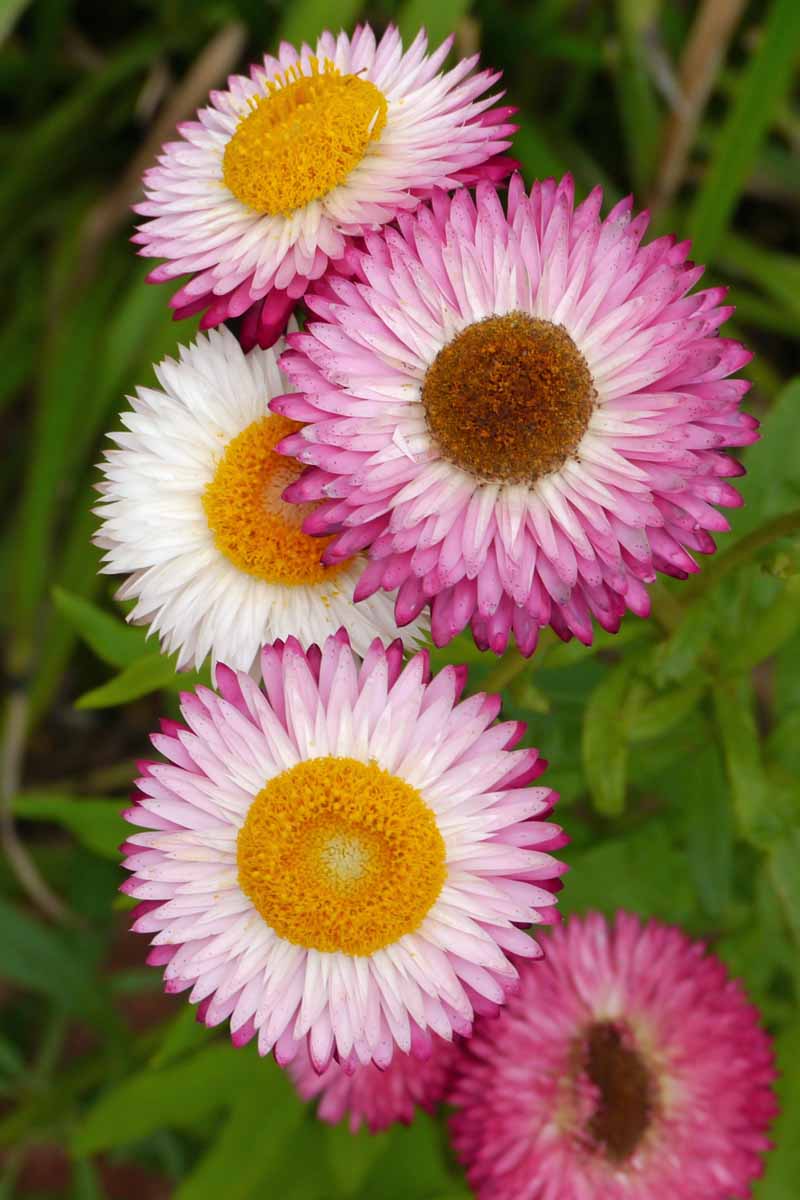
With a change of water and a daily snip to the bottom of each, the stems should stay firm for up to 10 days in a vase. You may wire them for added support.
To harvest strawflower for dry arranging, cut stems in the same manner and bunch them together. Suspend the flowers upside-down in a dry location until the stems dry out. Use as desired for everlasting arrangements and craft projects.
Strawflower Quick Reference Growing Guide
| Plant Type: | Annual flower | Flower Color: | Purple, lavender, pink, white, peach, yellow |
| Native to: | Australian grasslands | Tolerance: | Deer, drought, heat, light shade |
| Hardiness (USDA Zone): | Short-lived tender perennial in 8-10; annual in 2-7 | Soil Type: | Organically rich |
| Bloom Time: | Summer to frost | Soil pH: | Slightly acidic, 5.5-6.5 |
| Exposure: | Full sun | Soil Drainage: | Well-draining |
| Time to Maturity: | 70 days | Companion Planting: | Bee balm, black-eyed susan, yarrow, zinnia |
| Spacing: | 10-12 inches | Uses: | Mass plantings, cutting, dried arrangements |
| Planting Depth: | Sprinkle seed on top of soil | Attracts: | Birds, butterflies, bees |
| Height: | 15-40 inches, varies by cultivar | Family: | Asteraceae |
| Spread: | 15-18 inches | Subfamily: | Gnaphalieae |
| Water Needs: | Minimal; dry to medium | Genus: | Xerochrysum |
| Maintenance: | Minimal | Species: | bracteatum |
| Common Pests: | Leafhoppers, grasshoppers | Common Disease: | Aster yellows, downy mildew, gray mold, stem rot, root rot, wilt |
What’s Not to Love?
Strawflower is one of my favorite annuals for two reasons:
First, its everlasting blooms are a floral designer’s delight.
Second, the kids in the family love to grow it, because they like the funky feel of the dry bracts.
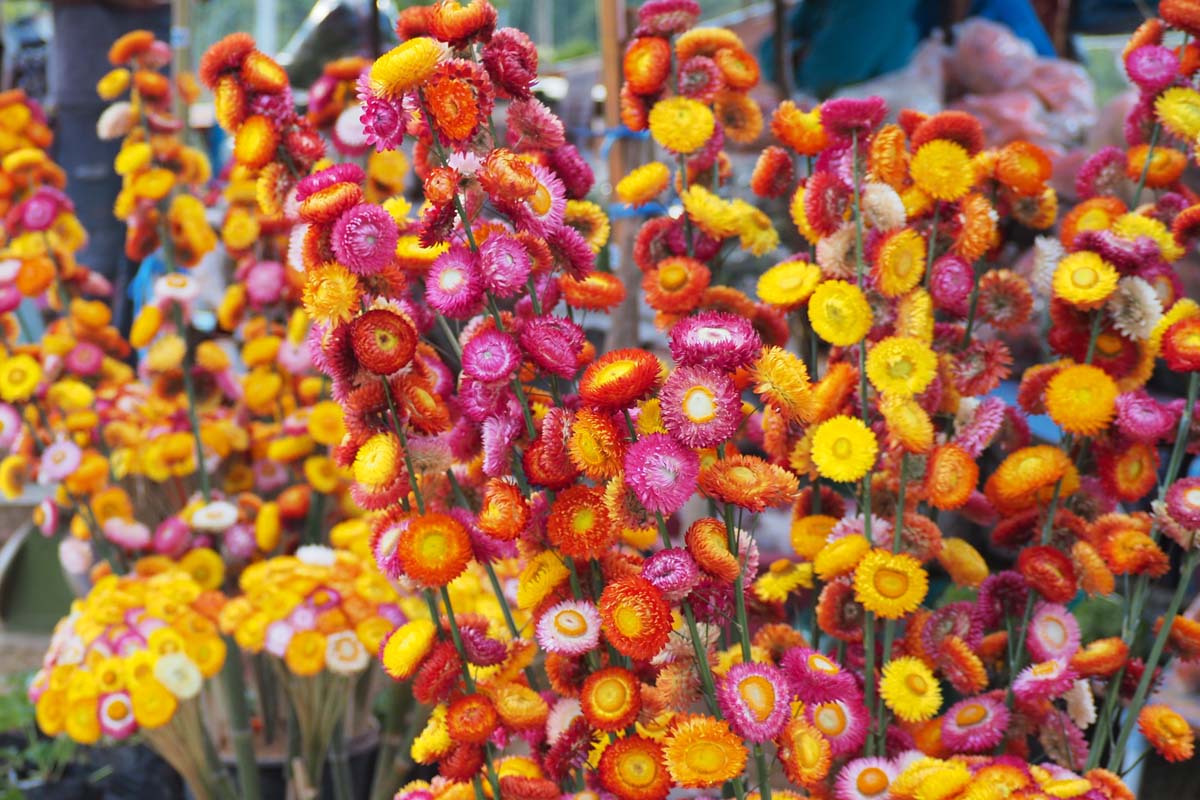
Bring this year’s gardens and containers to life with the vivid hues of strawflower, a unique annual that asks little, and rewards with continuous cut-and-come-again flowers from spring until frost. I know you’re going to love having it in your landscape as much as I do.
If you liked this article, you’re sure to enjoy:
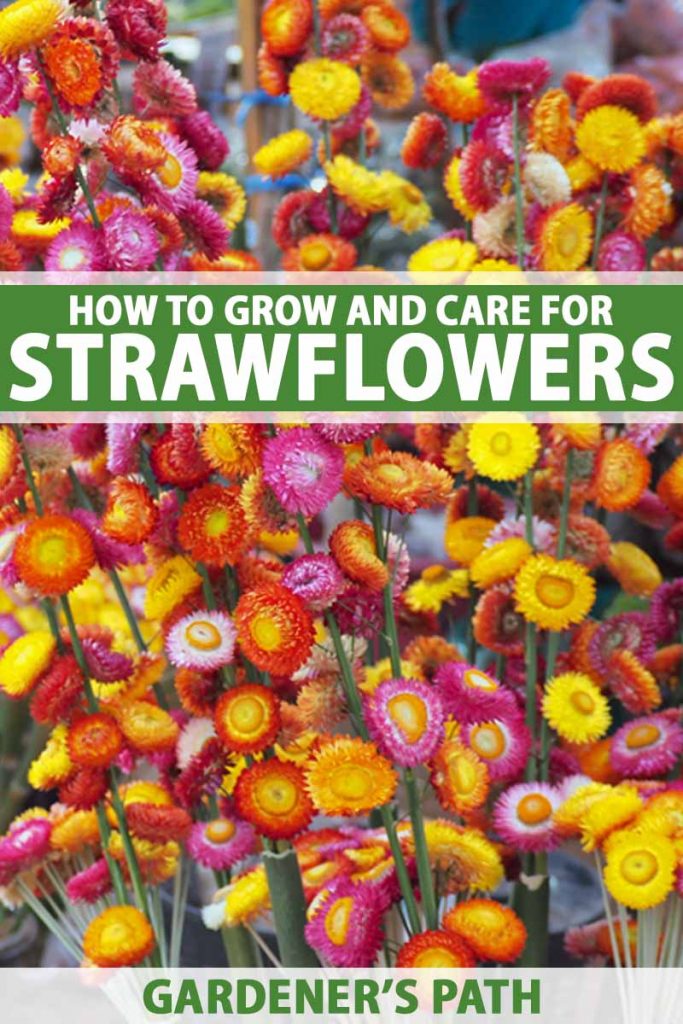

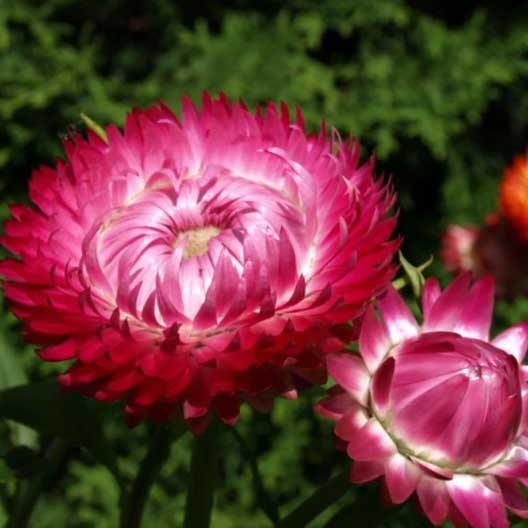
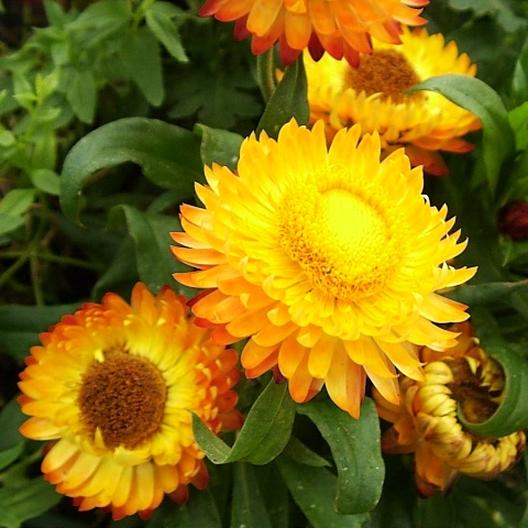
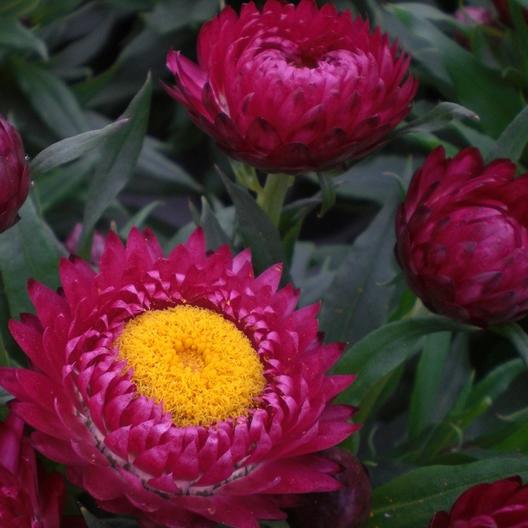
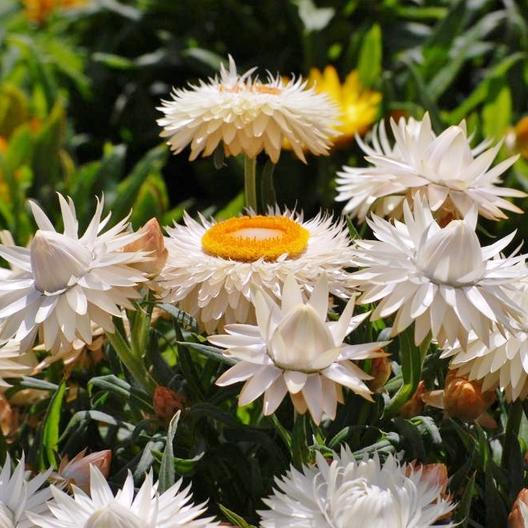
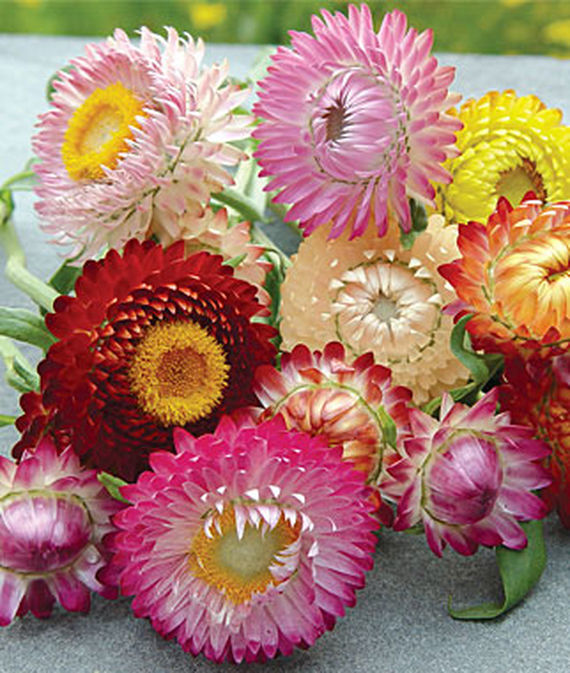
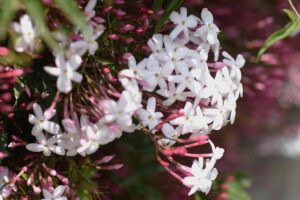
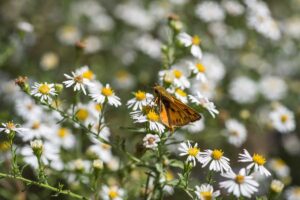
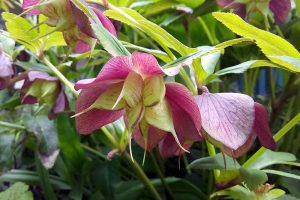
Help! My strawflowers have been over watered (I am new to growing anything) and they look sad. Leaves are brown and I think I might have killed them. Is there a way to bring them back? Thank you for your time.
Hi Teresa –
Sadly, strawflowers have little tolerance for excess water. The roots rot first, followed by the foliage. If the roots are mushy, there’s no way to recover the plants. It’s great that you’re getting into gardening. Don’t be discouraged. We can’t wait to hear what you grow next.
I have strawflowers seedlings coming up along with some unidentified seedlings. Is there a photo somewhere that I could see to tell the difference? If not could you describe them?
Hi Pauline –
The first true leaves of strawflowers are spring green with fine hairs and a rounded-elliptical shape. As they grow older, they are somewhat more pointed and more of a gray-green.
Can you keep straw flowers in the house over the winter?
Hi Joe –
Strawflowers are tender perennials in USDA hardiness zones 8 to 10, where winter temperatures range from about 10°F to 40°F.
To mimic winter dormancy outdoors, you can try placing your plant in a dry location with a temperature that does not exceed 50°. Water sparingly, just enough to keep the soil from completely drying out, and do not fertilize.
Why do dogs like to eat these?
Hi Sue –
Like humans, dogs enjoy pleasant sensory experiences and love to chew crunchy food. The papery bracts of a strawflower are surprisingly crisp and probably taste like a treat.
Hi, Sue. I planted strawflowers in ground level box containers and would like to move the plants to another location. When is the best time to transplant? I live in zone 6.
Sorry. I meant Nan, not Sue.
Hi Regina –
Unfortunately, in Zone 6, strawflowers are annuals and not likely to come up again. They are perennial in Zones 8 to 10.